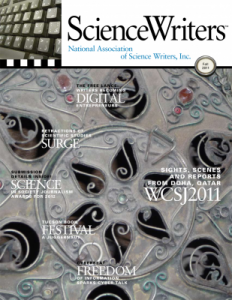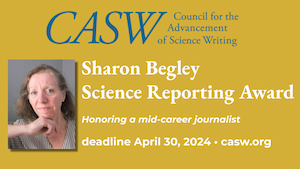“Scholarly Pursuits”
By Ben Carollo and Rick Borchelt
The areas of science and risk communication are inherently linked — and in more complex ways than one may think.
From time to time, all science writers likely will find themselves writing about risk. Those of us who work in the biomedical sciences and emerging technology fields may find ourselves in this position more often than others — and sometimes quite overtly — but issues of risk can creep into all of our work to varying degrees, whether we are writing about a meteor shower or genetically modified organisms (or earthquakes and hurricanes, as East Coast writers experienced as this article was being prepared).
There is a good deal of academic research that focuses on risk communication, social construction of risk, and how certain theories apply to communicating with specific populations about specific issues. We saw several papers over the last few months that really help provide some context about the world views of our audiences.
Russell, Laura D. and Austin S. Babrow
“Risk in the Making: Narrative, Problematic Integration, and the Social Construction of Risk”
Communication Theory 21(3) (2011) 239-260.
Science writers often talk about the importance of narrative in effectively communicating about science. The authors here explore the role that narrative plays in social construction of risk, ultimately evaluating news coverage of contemporary risks and using this analysis to pose several ways in which risk can be understood as a social construction.
Russell and Babrow spend a great deal of time reviewing the literature related to narrative construction and problematic integration, but there are several recurring themes. The first theme relates to how we use narratives to construct reality and how without them we would not be able to understand the world around us and the cultures in which we live. A second theme is the importance of temporal construction to these narratives and how past events are seen as causes for current events and that future events are determined by past and present actions. Finally, the way we conceive of the world, and thus risk, through narratives is a social construction that is self-reinforcing — and highly dependent on cultural cues.
The authors use various frameworks for conceiving of risk, but these frameworks generally focus on risk as occurring when there is some level of uncertainty for our well-being thrown into the narrative. In the temporal frame, this means that past events lead us to have uncertainty in the present about future outcomes. This is where science is introduced to the picture, as science narratives provide understanding of our experience as well as hold implications for our well-being. As the article notes, “To see risk … we must be able to foresee potentially adverse consequences of our actions, we must be able to choose freely among alternative actions, and we must in fact choose and enact those choices (including inaction).” Without science, this becomes significantly more complicated. But science is a double-edged sword when it comes to risk: in addition to providing a narrative about the known, science introduces an element of uncertainty, as in many cases we are entirely unable to predict what will happen as a result of scientific innovation.
Russell and Babrow also note that if risk is a social construction, our conception of risk is dependent on communication with other individuals and entities in society. In particular, they look at the implications of this concept as it applies to news coverage of risks. In the context of the importance of temporal construction, they assert that the approach to constructing a traditional news story (the five Ws and H) is really only appropriate when covering an acute risk with readily ascertainable dimensions. When the story becomes complex, a simple event structure does not provide enough alternatives to construct a complete narrative, thus introducing a greater perception of risk. The authors do not pose an alternative, but suggest that there are many ways that communication contributes to how people construct risk narratives for themselves and that our approaches to doing so will evolve over time.
Alum, Nick
“What Makes Some People Think Astrology is Scientific?”
Science Communication published online 13 December 2010
Accessed online 8/31/11
“It is one thing to read an astrology column for amusement or entertainment but quite another to believe that astrological predictions about events or personality will come true,” Alum notes in his look at perceptions of astrology and the implications this might have for those engaging the public about scientific issues. He explains why some people may place stock in astrology by analyzing European Commission data from the Special Eurobarometer 224 and 225 surveys, so keep in mind that there may be some Eurospecific cultural influences at play.
The author’s research questions focus generally on how scientific literacy affects an individual’s ability to distinguish science from pseudoscience, if misunderstanding about the nature of astrology contributes to faith in astrology, and whether ascribing to authoritarian values contributes to faith in astrology. As a Cancerian and a Taurean, we find some of the results to be quite fascinating. Of particular interest, more respondents rated astrology as “very scientific” than “not at all scientific,” while for the alternate term horoscopes, the majority of respondents saw horoscopes as “not at all scientific.” We should note that astrology was seen as slightly more scientific than economics, but only slightly less scientific than psychology. Further analysis suggests that, even though horoscopes and astrology are essentially the same thing, perceptions varied greatly on the choice of word used to describe the topic. Alum analyzed these results using various quantitative approaches, and he ascribes 17 percent of the variance in responses to this semantic confusion.
Additionally, not surprisingly, higher scientific literacy (having formal science knowledge) is positively associated with an ability to distinguish between science and pseudoscience. However, being well-educated and having a college degree was not seen, on its own, as enough to make a difference in perceptions. The author suggests that, though his analysis did not look at these issues, this finding may apply in the context of individuals making health and consumer choices as they navigate pseudoscience in their daily lives, as might be the case when a consumer considers various homeopathic remedies for an ailment or contemplates purchasing a “miracle” wrinkle cream advertised in a late-night infomercial.
Heiss, Sarah N.
“'Healthy' discussions about risk: the Corn Refiners Association’s strategic negotiation of authority in the debate over high fructose corn syrup.”
Public Understanding of Science published online 31 March 2011
Accessed online 8/31/11
The author begins this article by citing D.A. Lupton: “Though many substances can be consumed, cultural beliefs and traditions shape public understandings of what is edible, what is safe, what is healthy, and what is just too risky to eat,” taking us down the path of looking at some real life implications of the theories advanced by Russell and Austin. Heiss notes the lack of neutrality in risk discourses, which adds an additional dimension to the conversation. Here, she has chosen to undertake a close textual analysis to explore the rhetorical approach taken by the Corn Refiners Association (CRA) to influence the national dialogue about high fructose corn syrup (HFCS) in its “Sweet Surprise” campaign, which sought to create a “healthy discussion” about HFCS in light of studies that suggested a link between HFCS and obesity.
The author’s analysis of the various advertisements shows that the CRA relied heavily on a deficit model to construct a narrative where only certain stakeholders held relevant opinions. The campaign emphasized the use of generalized “health expert” figures to promote a discussion that focused on integrating HFCS as part of a “balanced” diet, creating a narrative where poor personal choices were the basis for any obesity link. While health experts’ opinions were validated, the public was consistently portrayed as uninformed and unable to process basic scientific information. Not surprisingly, scientists were absent from the narrative entirely, as it was the scientific community which had first suggested a risk associated with HFCS. By excluding scientists and dismissing scientific arguments in the narrative, the CRA was able to avoid presenting a balanced scientific debate in its campaign while simultaneously steering clear of the certain criticism that would be faced by presenting only one scientific perspective.
Though CRA’s tactics construct an effective narrative on behalf of its member organizations, the implications for the public discourse on science are disturbing. Reinforcing Russell and Austin, Heiss points out that we recognize the role of science in creating risk, and thus we become skeptical of the context that science provides us. And, in fact, the CRA advertisements quickly portrayed those people who intended to introduce science into the argument as uninformed, wrong, and worthy of ridicule by peers. In light of the concept of risk narratives, this type of advertisement has the potential to negatively affect the way a person views science in the way he or she constructs risk, which could significantly set back the efforts of many science writers to inform public discussion.
This raises questions about the role of science writers, in providing important context for sciencebased conversations when there are biased stakeholders with open kiosks in the marketplace of ideas. The author calls for the development of an ethical framework for trade associations to follow in stakeholder engagement, but we’re frankly skeptical of this approach and anticipate that third parties will be required to more proactively engage by providing additional c bird ontext to the discourse.
“Scholarly Pursuits” features articles from journals produced in the United States and abroad. If you read an article you think would make a good candidate for this column, send it along to rickb@nasw.org.
Ben Carollo leads the issues analysis and response team at the National Cancer Institute at NIH. Rick Borchelt is special assistant for public affairs to the director of the National Cancer Institute at NIH.

.png)

